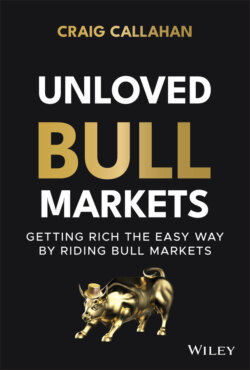Читать книгу Unloved Bull Markets - Craig Callahan - Страница 22
Unloved? Why?
ОглавлениеFigure 1.8 is the S&P 1500 Index from January 30, 2009 (about one month before the bottom) through the peak February 2020. Impressive, as even a cursory look boggles the mind. There were a few dips and pauses along the way but with 20/20 hindsight it appears it would have been easy to just buy and hold and go for the profitable ride. So why did investors net redeem out of equity mutual funds? Why was investor sentiment mostly below average? Why did public funds reduce their equity exposure as a percent of assets? What was happening that kept investors from embracing this bull market like they did previous bull markets?
Figure 1.8 S&P 1500 Index 1/30/09–2/19/20
Throughout the eleven years there was no shortage of skeptical, bearish commentary in the financial media and from advisory services and professional money managers. As for the books, one of the early ones, first published in 2010 and updated in 2012, predicted a decade of slow economic growth and deflation based on deleveraging. Regarding stocks, the author predicted falling P/E ratios, muted price appreciation, and recommended avoiding stocks related to big ticket consumer purchases, consumer lending, and homebuilding. He favored buying Treasury bonds, consumer staples, and North American energy. (Chapter 2 will confirm how wrong these predictions and recommendations were.) A second book in 2014 based its view on demographics and predicted the economy would fall off a cliff and that the stock market would be terrible from 2014 to 2019. The author warned that you needed to prepare for the worst downturn and crash of your lifetime beginning in early to mid-2014. A third book in 2018 labeled the bull market “fake” and claimed we could fake a bull market for just a short, limited amount of time. The author based the potential for a severe market reversal on global debt and Federal Reserve policy. Rather than fake, a 530% gain in eleven years and a 765% gain through August 2021 seems very real to an investor who participated. Did the books influence investors and contribute to their bearish sentiment or did investors’ predetermined bearish position simply make them receptive the gloom and doom theme? Maybe a little of both.
As for regular commentary, there were fears of higher inflation, deflation, double-dip recession, and rising interest rates at various times along the way. Early on many skeptics didn't like what they called “bailouts.” Some thought the easy monetary policy made the bull market phony, fabricated, and unsustainable. Some investors did not think the unemployment rate was dropping fast enough. Negative interest rates, new and puzzling for this generation, scared many investors away. Valuation seemed to be a problem for many because there were frequent claims that stocks were too expensive. Chapter by chapter, let's look into these situations and see if there was a lesson to be learned. After all, there will be more bull markets in the future, and we don't want to miss out on them.
